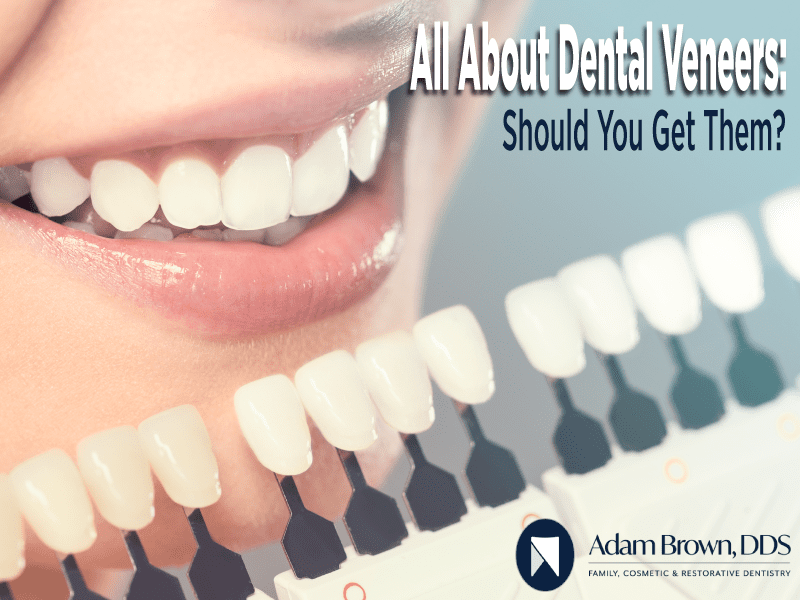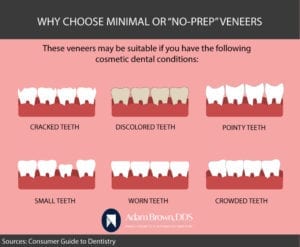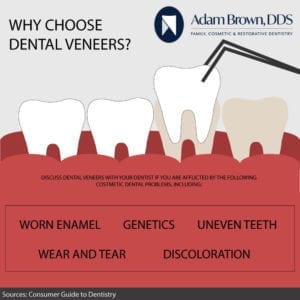Why Do I Have Naturally Stained Yellow Teeth?

Despite the guarantee of many whitening products—the strips, the trays, the paint-on whitening liquid—not all teeth, or stains on the teeth, respond to these products.
So now for the million-dollar question: if these whitening products aren’t working, am I destined to have yellow, stained teeth for the rest of my life?
Luckily, the answer to this question is NO. There are a number of possible reasons your teeth are not responding to whitening agents and narrowing down the possibilities as to why is the first step in finding the culprit and solution to your naturally stained teeth.
At Adam Brown, DDS we know how frustrating it can be trying to get and maintain white teeth, especially since not all teeth are created the same; some respond well to whitening agents, while others don’t need whitening agents at all in order to show that pearly glow. For those of us with naturally stained or discolored teeth, the prospect of getting them to a whiter shade seems futile, but it’s important not to give up hope. The truth is, regardless of the level of staining, you can have white teeth.
When it comes down to it, there are only three options, and they should be followed in this order:
• Make sure you are cleaning your teeth properly. Brushing and flossing daily is not only important for your oral health, but it will also remove stains that are not natural or permanent. There is really no way of knowing if your teeth are naturally stained if this step has not been taken. If you are unsure whether you are properly cleaning your teeth or not, see your dentist right away—he will be able to let you know pretty quickly.
• Try whitening agents. Once you are confident those teeth are being kept clean, try some whitening agents. It’s a good idea to consult your dentist on this first, as he can point you in the direction of those products that will work best for you—some can irritate sensitive teeth, and others might not be strong enough for what you need.
• Consider veneers. Veneers are a coating that goes over your teeth (permanently) and is the fastest way to brighten that smile. For those teeth with stains that simply won’t respond to regular cleaning and whitening, veneers are your only option.
Strategies for Keeping Healthy, White Teeth
When trying to find the culprit for naturally stained teeth, focus on your daily cleaning routine. Beyond brushing and flossing, there are a few other things you can do to keep those teeth healthy—and hopefully stain-free.
1. Drink Through Straws Whenever Possible
Any liquid with additives like sugar or caffeine can negatively affect your teeth, but there is an easy way to keep most of the liquid from having too much contact with your teeth: use a straw. By using a straw, you can keep liquid from contacting and leaving some residue on your teeth. You can use a wide straw for thick juices, narrow or regular-sized for normal densities, or even a bendy straw just because they’re fun. (Do stay away from those trendy metal straws though, as they can chip your teeth.)
2. Always Have a Water Chaser
The more time acidic liquids have to rest in-between and on the teeth, the better the chances of stains and erosion, and you know what that means: more trips to the dentist and quite possibly some intensive dental work to be done. So, even if you use a straw, it is a great idea to have a glass of crisp and clean water to drink from between each gulp of non-water you take. A quick swig of water makes those acidic bits difficult to stick around and manages to rinse any residue left behind that would stain the teeth.
3. Get the Right Toothpaste
A lot of people like to rush right to the whitening toothpaste. It makes sense, if it says “whitening” it must work, right? Well, not on all teeth. Sensitive teeth and gums can clash with the harsh chemicals in whitening toothpaste, and this can cause a lot of discomforts. It’s better to use toothpaste that is made for sensitive teeth. This will clean the teeth well without hurting them, and if your teeth are clean and the stains remain, the toothpaste is not your issue. Use toothpaste for sensitive teeth and brush twice a day. If there are removable stains on your teeth, this should help.
4. Avoid Over-Brushing
Never thought you could brush too much, did you? Well, you can. Too much brushing can actually help acid and bacteria erode the enamel off your teeth, turning them to a dingy yellow color. When you brush, use a soft or medium bristle; brush lightly, and use a mechanical toothbrush if possible. These are made to get to those hard-to-reach places and they put the perfect amount of pressure on your teeth and gums.
5. Use Mouthwash Regularly
Just like flossing and brushing, the twice-a-day rule is all you need with mouthwash. If you feel the need to rinse more than that use water, but once in the morning, then again at night, can do wonders to clean the mouth. Mouthwash also helps keep your teeth white and your breath fresh.
6. Visit Your Dentist Twice a Year
This is one of the most important things to do. One visit to the dentist every six months is the perfect way to gauge the health level of your teeth, as well as, document what is and is not working as far as whitening. Your dentist can tell if your teeth are becoming too sensitive or more stained and advise you on what to do. It’s also good because you get a professional cleaning where someone is meticulously searching your mouth for cavities, bits of food, permanent stains, or anything else.
Tips for Whitening
One possible reason those stains aren’t disappearing is that you are using the wrong kind of whiteners on your teeth. Each year there seems to be some new teeth-whitening trend, but not all of these methods effectively work to brighten that smile. There is one newer method catching attention that is showing some spectacular results for users. It’s called LED lighting and dentists and patients are beginning to take a closer look at this advanced method of removing coffee, nicotine, and seemingly permanent stains from the teeth. But is using LED lighting—or, blue lighting, as it is often called—for whitening teeth a safe practice? Though the results of this particular whitening method are positive, patients are still citing some enamel loss and increased sensitivity. Luckily, doctors have just recently discovered an even newer method, still using LED lighting, to whiten teeth but without the negative effects.
Here’s how it works: A gel is applied to the teeth then LED lights are used to trigger photocatalysts in the teeth, which then brighten and whiten. The gel is used to speed up the process and make the LED light more effective.
Though the chemicals in the gel used in conjunction with the LED lighting may not be quite as powerful as what’s used in other strips or gels, this process can still be harsh on the teeth—especially sensitive teeth. This has caused a bit of backlash, but this method is still seen as a step in the right direction, as it is not as intense as other take-home whitening products.
Before You Whiten
Though it is tempting to buy the most popular take-home whitening products on the market, be careful of what you get. Just because your friend has found a product that works to remove those pesky stains without causing sensitivity and enamel loss, it doesn’t mean the results will be the same for you.
Your first step is to come in and meet with Dr. Brown and his team. They can successfully assess your teeth and gums to forecast which method(s) might be best for you. But, if you absolutely must start the whitening process immediately, follow these tips until you can come to see us:
- Keep away from trays and gels. The problem with this method is that it can take weeks for results to show. And, most people who use the tray and gels report having teeth sensitivity afterward.
- Use caution with whitening strips as well. Though results can show in about a week, over time, this can cause irritation. Also, if you use the strips too often, your teeth can become sensitive.
- When you have the time to wait, use a paint-on. The paint-on method solves the problem of the whitening agent interacting with interior soft tissues, such as the gums and inner cheek. You simply brush the whitening gel on each tooth and let it sit for a short period of time. The only downside to this method is it can take months before results can be seen, and you have to be diligent in getting the gel on each tooth daily.
- Whitening devices are your best option. Go ahead and do a little research and find an LED lighting kit to order—you can get them off Amazon.



